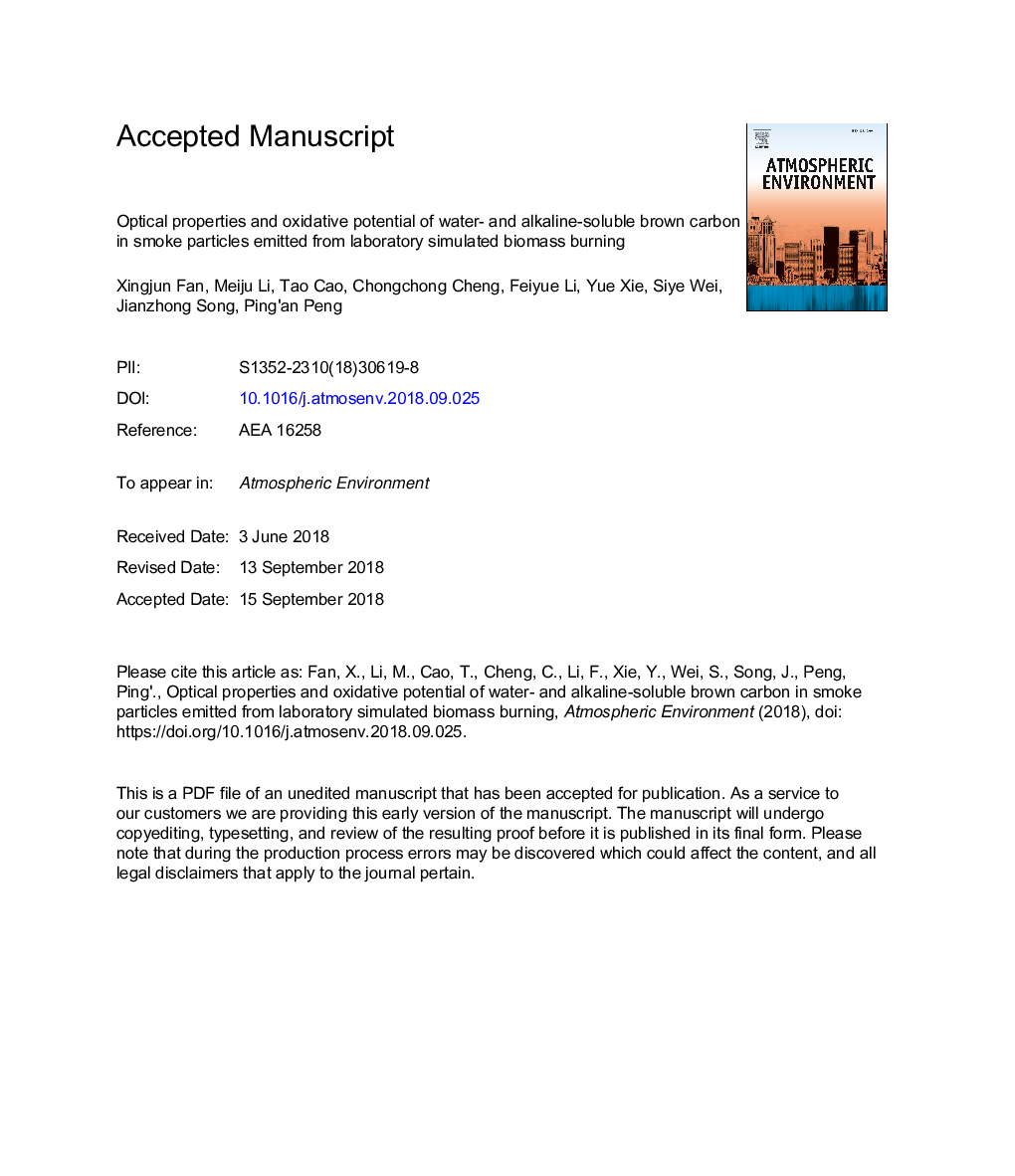| کد مقاله | کد نشریه | سال انتشار | مقاله انگلیسی | نسخه تمام متن |
|---|---|---|---|---|
| 10223586 | 1701033 | 2018 | 35 صفحه PDF | دانلود رایگان |
عنوان انگلیسی مقاله ISI
Optical properties and oxidative potential of water- and alkaline-soluble brown carbon in smoke particles emitted from laboratory simulated biomass burning
ترجمه فارسی عنوان
خواص نوری و پتانسیل اکسیداسیون کربن قهوه ای محلول در آب و قلیایی در ذرات دود منتشر شده از سوختگی زیست توده شبیه سازی شده آزمایشگاهی
دانلود مقاله + سفارش ترجمه
دانلود مقاله ISI انگلیسی
رایگان برای ایرانیان
کلمات کلیدی
سوختن زیست توده، کربن قهوه محلول در آب، کربن قهوه محلول قلیایی، اموال نوری، پتانسیل اکسیداسیون،
موضوعات مرتبط
مهندسی و علوم پایه
علوم زمین و سیارات
علم هواشناسی
چکیده انگلیسی
Biomass burning (BB) is an important source of brown carbon (BrC) in atmospheric aerosols. The aim of this study is to investigate the light absorbing ability and oxidative potential of BB-derived BrC fractions (including not only the water soluble fraction but the water-insoluble ones). For this purpose, BrC fractions in the smoke particles (PM2.5) generated from burning of crop residues (rice straw, wheat straw, and corn straw) and wood stems (pine wood and Chinese fir) were sequentially extracted and fractionated into water- and alkaline-soluble extracts, and water- and alkaline-soluble humic-like substances (HULISWS and HULISAS). Their organic carbon (OC) contents, light absorption, and oxidative potential were comparably investigated. The results showed that the OC within water extracts (WSOC) and alkaline extracts (ASOC), and HULISWS and HULISAS accounted for 24.8%-28.5%, 10.7%-15.3%, 12.4%-16.6%, and 2.2%-5.6% of the BB smoke PM2.5 mass, respectively, thereby indicating that BB potentially influenced the atmospheric water-soluble and alkaline-soluble BrC levels. The BrC fractions had similar absorption patterns, but they also exhibited distinct features. BrC SUVA254 decreased in the order of: HULISAS (3.68-4.58â¯m2/gC)â¯>â¯HULISWS (2.99-3.72â¯m2/gC)â¯>â¯WSOC (2.54-2.80â¯m2/gC)â¯>â¯ASOC (1.30-2.06â¯m2/gC). BrC MAE365 was in the order of: HULISAS (1.95-2.40â¯m2/gC)â¯>â¯HULISWS (1.12-1.60â¯m2/gC)â¯>â¯WSOC (0.86-1.23â¯m2/gC) and ASOC (0.54-0.95â¯m2/gC). These results suggest that the HULIS fractions exhibited high aromaticity and strong light absorption. Moreover, BB extractable fractions exhibited a strong oxidative potential to generate reactive oxygen species, and the dithiothreitol activity followed the order of: water extracts (12.5-20.6â¯pmol/min/μg)â¯>â¯alkaline extracts (9.3-16.2â¯pmol/min/μg)â¯>â¯HULISWS (6.6-10.7â¯pmol/min/μg)â¯>â¯HULISAS (3.7-7.1â¯pmol/min/μg). The chemical characteristics of the BB BrC fractions also varied among the biomass types, where the crop residue smoke PM2.5 contained more BrC than wood smoke PM2.5, but the water-soluble BrC in the former generally exhibited weaker light absorption than the latter.
ناشر
Database: Elsevier - ScienceDirect (ساینس دایرکت)
Journal: Atmospheric Environment - Volume 194, December 2018, Pages 48-57
Journal: Atmospheric Environment - Volume 194, December 2018, Pages 48-57
نویسندگان
Xingjun Fan, Meiju Li, Tao Cao, Chongchong Cheng, Feiyue Li, Yue Xie, Siye Wei, Jianzhong Song, Ping'an Peng,
